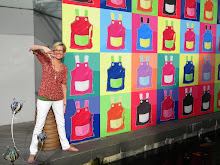 Look. It’s one of
those words that sounds like what it is commanding. Pointing at the sky, the clipped syllable
could almost be emanating from the projecting finger. Look.
Look. It’s one of
those words that sounds like what it is commanding. Pointing at the sky, the clipped syllable
could almost be emanating from the projecting finger. Look.
I’ve been thinking about looking lately as I’ve been
struggling to get a good pair of eye glasses.
The last pair was shipped back to the US when, after two weeks of
continual headaches and less than adequate vision, I gave up on the really chic
frames and asked for a refund. Which put
me back at the beginning. No glasses
except the pair I had made in December 2010.
Vision is great in them, but they were beginning to show some serious
signs of wear.
Off I went in search of a Singapore eye doctor and my good
friend, L, (seriously, L is her first initial, so very appropriate for today’s
posting) put me onto Dr. Izaac at Paragon. Off I went for my reconnoiter. I learned this years ago during one of my
early moves. Always visit the office
before you make a commitment. It was more
than up to par, so I introduced myself and made an appointment for the
following Monday.
The doctor called me in, I explained my dilemma and the
difficulty I’ve had as I get older and my glasses get more complex, and he
assured me he could make a pair of spectacles that would work for me.
Forty-five minutes later after a battery of tests and options – which is
better, 1 or 2, 3 or 4, you know the routine – I went out to select the
frames. The doctor’s mother was visiting
from LA (another L) and, with her input and the help of the optician, I found a
pair that fit my face and my taste, if not my budget. Then out came the doctor again – he approved
and spent a few more minutes marking the frames.
Five days later, back I go, apprehensive, skeptical, and
still a bit in shock over the cost.
Twice as much as I’d paid in the U.S. The doctor comes out to greet
me, takes me back to the examining room, puts the new glasses on me, and I can
see! Yes, I can see immediately. No blurring, no straining. With the last pair, I had not been able to
see when I first tried them on. The
optician assured me they would settle…I tried to convince myself it was true,
that my brain would eventually adjust. It
never did.
I was delighted. How
had he done it? Well, he explained, he
had owned the entire process – the exam, the prescription, the frames, the
fitting, the delivery. This wasn’t the
case in the U.S. The process is fragmented – the doctor who
examined me there never knows whether his prescription was made correctly or
whether it worked for me in the end. The
involvement with the patient and the product from beginning to end over 30
years, Dr. Isaac explained, was a great source of learning about how to do what
he does. Imagine that – it’s about the
relationship, not efficiency, not cost, not speed, not pushing product. Improving vision by talking to the patient,
understanding what works and what doesn’t and then being committed to the end
product? What a great idea!
The Industrial Revolution separated our hearts from our
hands as work became fragmented, impersonal and mechanized. How can we recapture the humanness? Perhaps we cannot change the underlying
structures, we probably don’t want to in many cases because the modern world
affords us a lot of conveniences, but we can own the part of the work that is
ours. We can take pride in what we
do. We can treat one another as human
beings, not customers, clients, fans, followers, headcount, or any other
dehumanizing and relationship-choking terms we may put on the people we work
with and serve every day. Easier said than done, I know. But we can start by putting names to faces –
the clerk in the grocery store, the teller at the bank, the janitor in the
office, the weird guy who never looks up as we pass every day in the corridor
on the way to the coffee room. We can start with a greeting and smile for every
human being that we encounter today. We can start by looking. There. Right there. Look.



No comments:
Post a Comment